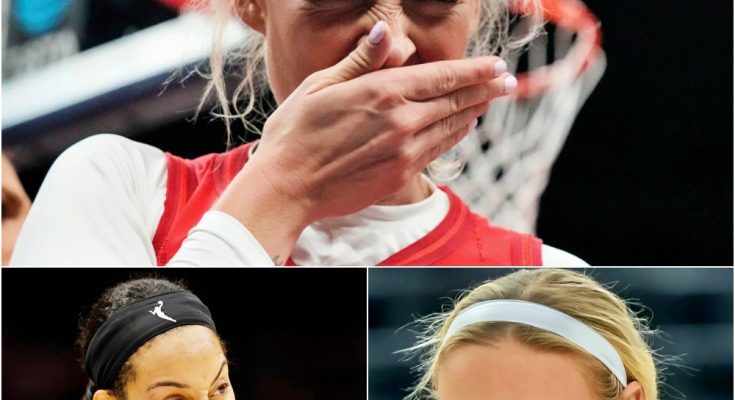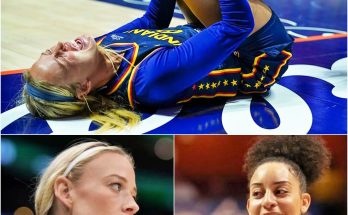
A shock ripped through the WNBA this week, and the silence that followed was even louder. Sophie Cunningham — long seen as the fiery heartbeat of the Indiana Fever — has suddenly vanished from the season. No warning. No long explanation. Just a blunt line that confirmed the fears of her fans and set off a storm across social media.
It wasn’t the kind of announcement that matched the weight of what happened. It was cold, clinical, and almost dismissive. A one-line press release landed on Monday: Sophie Cunningham would miss the remainder of the 2025 season after being injured against the Connecticut Sun on August 17. And almost in the same breath, another update followed: the Fever had signed veteran guard Shay Petty to a seven-day hardship contract.
One out. One in. Just like that.
To the league, it may have seemed like business. To the fans, it was betrayal.
The night that changed everything began like any other. The Fever stepped into Mohegan Sun Arena to face the Connecticut Sun. The crowd roared, the lights burned down, and the game tipped off under the sense that it was going to be physical. From the very first possession, every drive felt heavier, every screen carried extra force.
Sophie had lived for games like this. She built her reputation on grit. Diving for loose balls, clapping in opponents’ faces, smirking through bruises. Fans loved her not because she was the flashiest player, but because she was fire — relentless, unapologetic fire.
And then came the moment.
Bria Hartley slashed through the lane. Sophie stepped in her path. Hips met, balance tangled, and in the space of a single breath Sophie’s right knee buckled. She fell to the floor, gasping, clutching her leg.
The crowd froze. The sound of sneakers and one sharp gasp from Sophie filled the arena. People waited for a whistle. A review. Something.
Nothing came. The referees let the play roll on.
No flagrant. No technical. No stoppage.
By the time Sophie was helped off the floor, the realization settled in: this wasn’t just an ordinary knock. And worse — nobody had stepped in to protect her.
Fans can forgive bad luck. They cannot forgive silence. And in this case, it was the silence that cut deepest.
Clips of the fall hit X within minutes. The replays were dissected, slowed frame by frame. Some saw an unfortunate accident. Others swore it looked deliberate, a calculated strike. Hashtags burst into life: #ProtectSophie, #WhereWasTheWhistle, #PlayersNotDisposable.
But the real outrage wasn’t about Hartley or the collision itself. It was about what didn’t happen. No review. No accountability. No acknowledgement. A player had gone down, and the league moved on as if nothing happened.
And that, for fans, was unforgivable.
The anger only deepened when the team announced the signing of Shay Petty. On paper, Petty was a smart addition: a proven defender, a steady veteran, someone who could plug into the backcourt right away.
But paperwork moves faster than emotion. To Fever fans, the timing was insulting. Sophie’s absence was not just a roster vacancy to be filled. It was the loss of a heartbeat.
The replies under the Fever’s official posts were ruthless.
“You can’t replace fire with paper.”
“She’s not a number on a roster, she’s the identity of this team.”
“Shay Petty deserves respect, but this feels like the league trying to erase Sophie with a signature.”
If the league thought the storm would pass quietly, they were wrong. Because Sophie’s family had something to say.
Her sister went public with a furious post that blew the debate wide open:
“Maybe you should focus less on fining players for comments and more on hiring officials who can actually protect your athletes. Pathetic. Praying for you, Sophie.”
That single line struck harder than the league’s entire communications arm. It wasn’t just a statement of frustration. It was an accusation — that the WNBA had failed at the most basic responsibility: protecting its stars.
Within hours, the post had been shared across platforms. Talk radio debated it, sports shows replayed it, and fans rallied behind it. The narrative shifted: this wasn’t just about Sophie Cunningham’s injury. This was about whether the league itself could be trusted.
By the next day, the fire had spread everywhere. Hashtags trended worldwide. Fan accounts posted slow-motion breakdowns of the collision, circling Hartley’s movement, highlighting Sophie’s collapse. Arguments raged: was it just bad luck, or had she been targeted?
Bars replayed the highlight in loops. Talk radio shows opened their phone lines, and every caller asked the same question: why wasn’t she protected?
One fan in Section 112 posted just three words under a clip: “Protect. Your. Players.” The phrase spread like wildfire, plastered under every WNBA highlight that week.
The more the league stayed silent, the louder the storm grew.
And what about Sophie? For years, she had been more than just a guard. She was the firestarter, the grit, the swagger. Analysts often said: “She’s the player every fanbase loves until she’s playing against you.”
Now that fire had been extinguished in an instant, and the way it happened left fans furious. Not because injuries don’t happen — everyone knows they do — but because of the feeling that when it did, nobody cared enough to stop the game.
That’s what lingered. The silence. The indifference. The replacement that came faster than the acknowledgement.
The fallout reached beyond fans. In Missouri, where Sophie grew up, even local politicians weighed in, calling the incident “shameful” and demanding answers about player safety. Sports unions began quietly discussing whether protocols had failed. Analysts accused the league of “gaslighting” its own audience by treating the injury as business as usual.
Everywhere, the same theme echoed: the WNBA was at a crossroads.
What happened in Connecticut wasn’t just one injury. It was a moment that crystallized everything fans feared about how stars are treated. The perception that fiery players are celebrated until they’re hurt, and then replaced without ceremony. That trust is a marketing slogan, not a reality.
The games will continue. Shay Petty will step in, put on the jersey, and play her part. But for fans, nothing feels the same.
Because this wasn’t just about Sophie Cunningham’s knee. It was about faith in the league itself.
The collision is still debated. Some call it an accident. Others whisper it was calculated. But the loudest question remains: why, when a star collapsed in obvious pain, did nobody protect her?
Until that answer comes, the WNBA will keep moving forward. But for fans, the silence remains deafening.
Disclaimer: The information presented here reflects publicly available reports, eyewitness commentary, and ongoing discussions across media platforms at the time of publication. Certain descriptions are written in a narrative style to capture the intensity of events and reactions. Readers should understand this piece as part of broader news coverage and analysis, not as an official statement from the league or involved parties.



